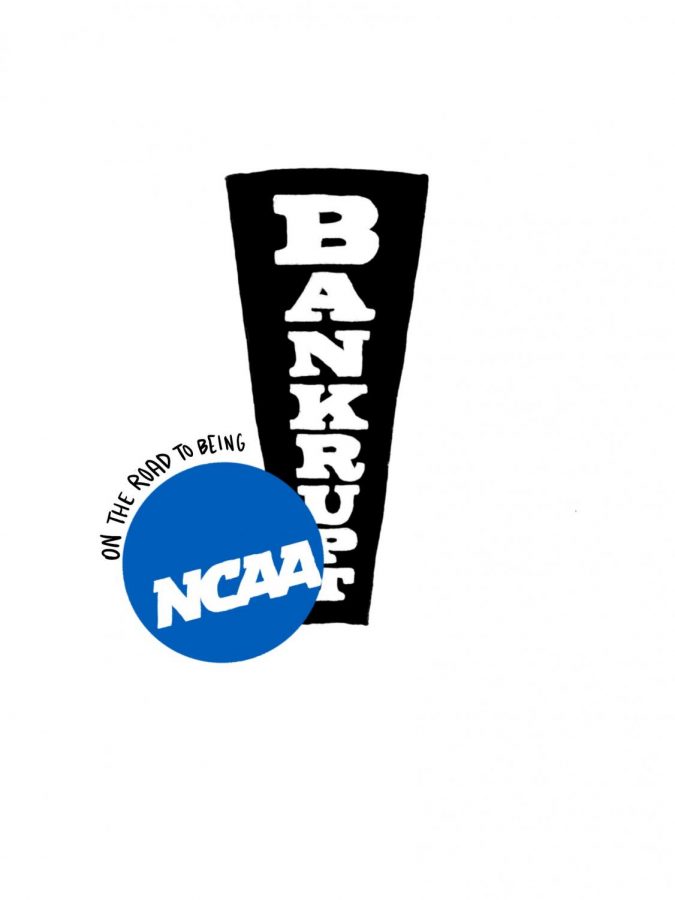COVID-19 proves detrimental to NCAA budget
How the loss of March Madness destroyed the NCAA financially
Most college sports fans look forward to the biggest event of every year, March Madness, with expectations of Cinderella stories and highlight reel buzzer beaters, but for the National Collegiate Athletics Association (NCAA), it is the event where the majority of their revenue is generated. The revenue, coming from media and broadcast deals and ticket sales, gets redistributed to NCAA member institutions making up the majority of budgets for these schools.
Early this year, the NCAA witnessed all of this crumble with the difficult decision to cancel the remainder of spring championships, including the March Madness tournament. What was supposed to have been upwards of $600 million redistributed to member institutions quickly fell to just $225 million, just over 37 percent of what was originally budgeted for.
At the beginning of each year, the NCAA releases a financial report of what their expected redistribution efforts will look like for the year. In January, they announced the $600 million figure to be distributed back to member institutions starting in April 2020. Just three months later in March, the Board of Governors voted unanimously to alter that number to $225 million, of which $50 million would come out of the NCAA reserve, essentially a “rainy day fund.” Not only did the figure decrease significantly, they also pushed back the redistribution start date to June 2020.
The “good” news for the NCAA is that they did have an event cancellation insurance policy for March Madness of a staggering $270 million to help make up some of the loss. That being said, it isn’t going to account for the years of funds that are promised to conferences from March Madness.
Although football appears from the outside to be the largest revenue stream, the key money that comes from the large football schools actually operates outside of the NCAA. For example, the Rose Bowl has contracts with the Big Ten and Pac-12 Conferences, not with the NCAA, and therefore the revenue generated from that event doesn’t get shared amongst NCAA member institutions at large. Because of this, the men’s basketball tournament is by far the largest stream of revenue that is directly associated with the NCAA and impacts the majority of member institutions.
SLU Senior Associate Athletic Director, Janet Oberle, said, “everyone has a basketball team,” when discussing the full participation of member institutions in March Madness. There are 68 teams that qualify for the tournament every year when you include the First Four, 32 of which are automatic qualifiers and 36 at-large bids that come from the selection committee.
When a team qualifies for the tournament, they receive what is called a “unit.” This unit equates to just under $267,000, which over the six-year period that the unit is promised, earns a conference about $1.6 million, per unit. Therefore, for conferences that have six bids, they are promised just shy of $10 million just for making the first round. If teams were to move further into the tournament, they would acquire more units, in turn earning more money for their conference.
Every conference is different in how they distribute their units, but it is common practice that the teams that go the furthest will get the majority of the money. Not only is this important for the teams that belong to these conferences, it’s not uncommon for the units to be a substantial portion of the conference’s yearly budget. For example, for the Southern Conference, their one guaranteed unit from their automatic qualifier makes up about 40 percent of their total yearly budget.
With the cancellation of the tournament, these unit payouts are going to be compromised and conferences are going to have to budget for the lost funds. As far a SLU is concerned, the A-10 Conference is in a decent place financially because they have been able to establish an endowed “rainy day fund.” “Some conferences aren’t as lucky,” said Oberle, “they will be hit harder because they didn’t have the resources to prepare for something like this.”
Oberle attributes the A-10’s preparedness to the great leadership in Newport News in the commissioner, Bernadette McGlade, and the financial team that helped create this fund. The source of the funds has come from conference entrance fees, extra units that teams have earned, and various other small sources. Due to this endowment, Oberle is confident that the A-10 will be able to sustain this year, but that doesn’t mean there won’t be some necessary cuts made to prevent any further damage.
The largest area that will be hit by these cuts will be student support. There are resources set aside each year to help student-athletes with various costs such as tutoring, necessary flights home, business clothes for job interviews and other services for student-athletes that might need the extra assistance. While these opportunities won’t be completely slashed for athletes, Oberle said, “we are just going to have to get more creative on how we can serve our students.” She was very adamant that the student-athlete experience is the most important thing and it is not something that the athletics department is willing to sacrifice.
Over the summer and throughout this fall, programs across the country have been cutting programs to try to reclaim some of the loss that they are going to see for the year—the biggest thus far being Stanford’s cut of 11 varsity programs. The fact that Stanford and Iowa have both made large cuts prove that not even the Power 5 schools are safe. Stanford’s $27.7 billion endowment couldn’t save these programs, leading to the assumption that other schools are going to be facing similar nightmarish scenarios.
When it comes to the pie chart of NCAA revenue for the year, the March Madness Tournament is the majority and any other source of income is just a sliver. Oberle compared it to a household with a single source of income. You have one person responsible for the majority of the income that covers just about all expenditures, but that doesn’t mean that maybe another member of the family brings in a little bit extra here or there. Losing the tournament would be like that single source of income losing their job, leaving the household to severely cut their budget.
This past Wednesday, the NCAA announced that they were going to be furloughing all of their Indianapolis based staff, roughly 600 people, for anywhere from three to eight weeks starting on Sept. 21 and running through the end of January 2021. Although this furlough doesn’t apply to the top executives, they all did take a pay cut of about 20 percent back in March while their vice presidents took about a 10 percent cut.
The with NCAA slowly falling apart due to all of the budget issues, it creates the questions of whether or not there should be any discussion of restructuring the NCAA to lessen the impact of a devastating loss of revenue like this year’s from ever happening again. Oberle believes that it is unrealistic to try to change the current model because “no one has any big ideas for how to change it,” but she does believe that at least now people will be “more thoughtful” and “more aware of the facts” of how the NCAA operates.
Your donation will support the student journalists of Saint Louis University.





